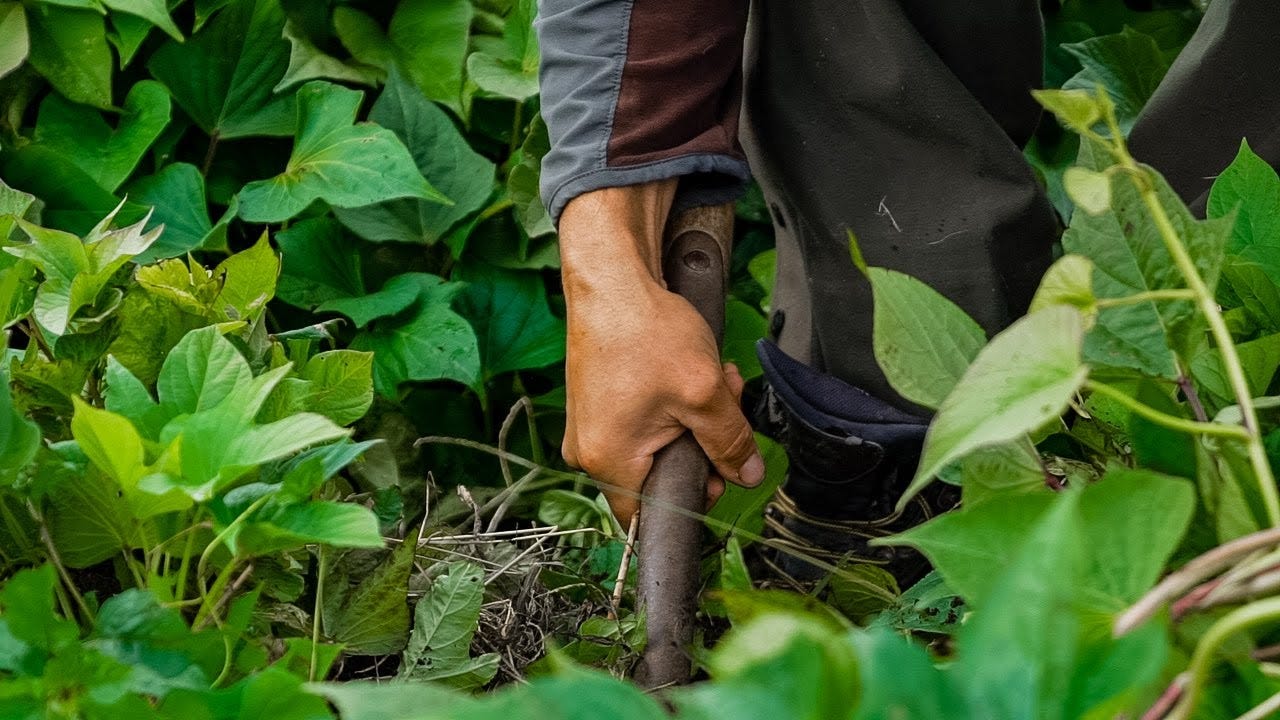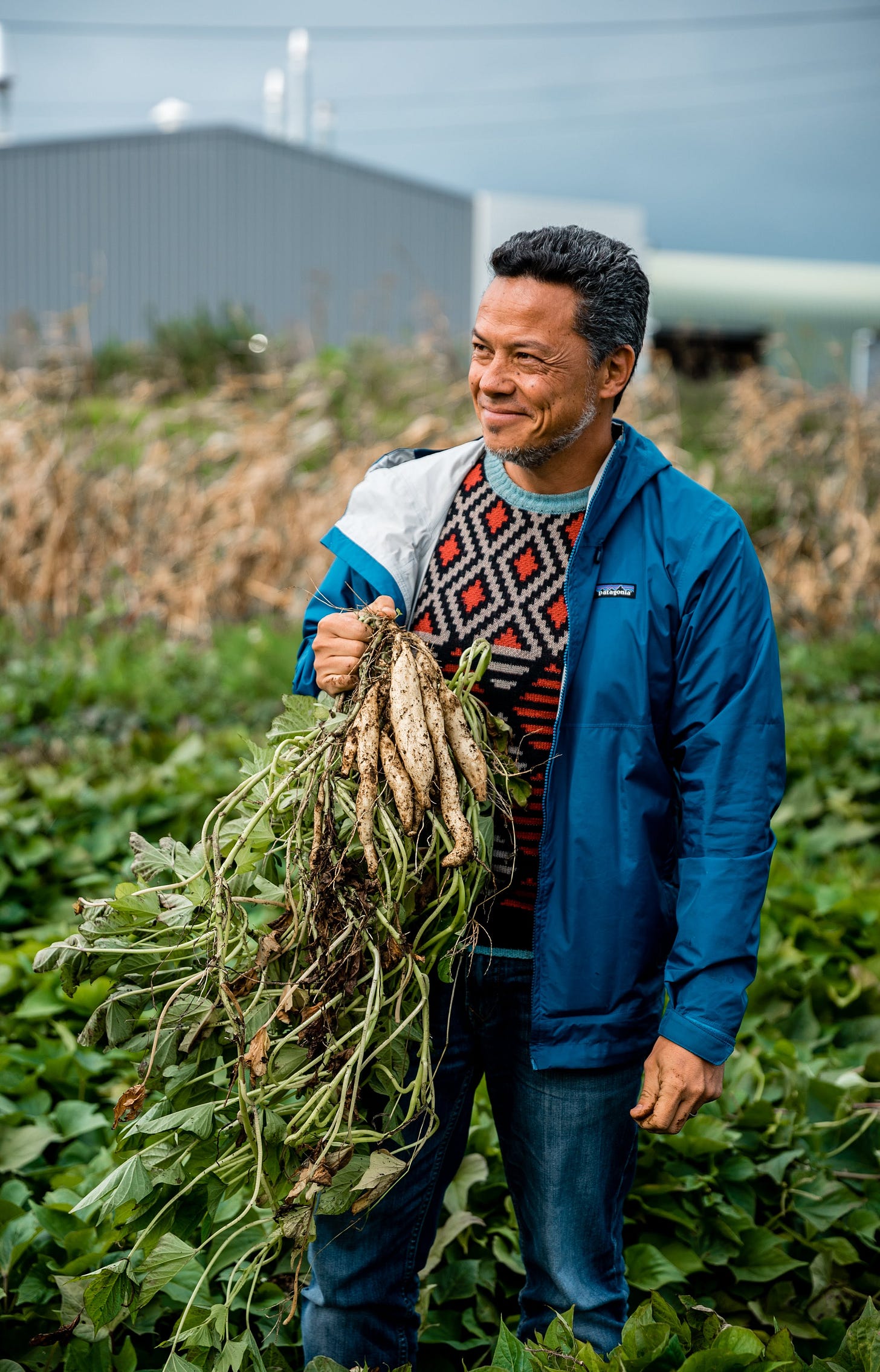In envisioning and creating a wilder world, the food we eat is an essential part of the picture. Whether we are conscious of it or not, eating is one of the most consistent interactions we have with the environment. As our world begins to feel the harsh effects of climate change, so increases the number of droughts, wildfires and erratic weather patterns, challenging Southern Africa's food security (let us not forget that Africa is likely to be the continent most vulnerable to climate change). There’s been a heightened importance to thinking about the food we consume over the last years. The question we can ask ourselves, as individuals, is how can we integrate small changes in our consumption patterns which can bring us closer to having a less harmful ecological (and social) footprint when it comes to the food we eat?
Connecting through FOO.D - 📷. ReWild with Eduardo ‘Shima’, New Zealand
How dependent is our planet on our food systems?
The WWF has identified food production and consumption as one of the strongest drivers of our planet’s declining health. But their studies also show that there are solutions, and we can implement solutions today which change the course of deterioration, restoring our natural systems and improving the health of our people.
“Our food systems have caused 70 percent of biodiversity loss on land and 50% in water; they’re responsible for around 25 percent of all greenhouse gas emissions; and they’ve caused 80% of global deforestation. Our dietary choices aren’t just damaging the planet, they are also damaging our own health.” - Brent Loken, WWF Food Scientist
It’s clear that our food production system is a strong driver of climate change. On the other end of the problem, food production systems are failing us. The UN estimates that the number of undernourished people in the world is around 690 million. Global hunger is increasing, despite the efforts of many global and local organisations. A key reason for this is the impact of the environment on food production, as extreme weather events, unpredictable weather patterns and increased spread of pests and diseases cause disruptions in agriculture. Another reason is high levels of import/export of food products. This makes food prices and availability susceptible to global market shocks and factors far beyond the control of local suppliers. It also increases the price of certain products, depending on their availability in a specific country. It’s a system of distribution which is fundamentally unsustainable. At a global level, we have to find new ways to approach food production and consumption.
One of the barriers facing us in implementing this change is the enormity of the problem. When confronted with a mammoth task, it’s easy for individuals and policymakers alike to experience a ‘freeze’ leading to a failure to take action. How do we combat this tendency to freeze?
A planet based diet 🌍
The WWF proposes adopting a “planet-based diet”. The wording is helpful because it cuts through the assumption that a plant-based diet is essential to changing the course of our food system’s impact on the environment. Eating vegan or even vegetarian is obviously a fast-track to reducing your impact, but the push to eat in this way can simply cause meat-lovers to ‘freeze’. The more moderate “planet-based diet” is helpful because it recognises that the ideal diet will look different in different places and for different people. It encourages us to eat foods which are planet-friendly, exercising moderation and returning to traditional dietary patterns where necessary.
Adopting certain principles around food production and consumption can also be useful for individuals, as we practice unlearning habits which aren’t benefitting our planet or our bodies. We’ll highlight just a few...
Local Consumption 🌾
One truly unsettling statistic is that we do, in fact, produce enough food to feed the world’s population. Environmental factors, storage issues, crop failures and problems in supply chains are examples of food loss which prevent produce from reaching consumers. There’s a lot that can be done to resolve that at the producer level, especially using the principles of biomimicry (discussed below).
For the consumer, one of the best practices we can implement into our daily lives is eating locally and seasonally. Food can be shipped around the world with relative ease, and the result is that we can easily feel that we can have any food at any time. But consider the amount of fossil fuel that goes into food transport and the environmental impact that we are having by, for example, choosing to eat avocados in summer or grapes in winter. Eating locally is better for the planet and easier on supply chains. If we want to eat locally, we have to learn to eat seasonally, and to store our food. This is not some long-lost skill of our ancestors, this is something that even our grandparents knew very well how to do. Pickling. Preserving. Dehydrating. Freezing. Sharing.
A culture of consumption 🍔
On the one end of the spectrum, we have undernourished societies in developing countries. At the other end, we have increasingly affluent societies who demand more processed foods, more red meat and more refined sugars and oils in their food. This type of eating has higher environmental impact and is often detrimental to our bodies. A tiny solution to such a large-scale problem is to think more carefully about the culture we create around food. How do we consume our food? Do we rely on ‘food-on-the-run’ with long lists of ingredients and heavy packaging? Do we give ourselves space to enjoy our food, preferably with friends or family, even in our busy lives? Do we eat to nourish and enjoy or simply to sustain? These questions might seem superficial, but the truth is that food culture and both human and environmental health are intimately connected.
Biomimicry and food systems 🐋
Biomimicry is the practice of learning from and emulating nature's genius. The practices of regenerative farming, which include permaculture, look to emulate the principles of highly productive natural systems. So regenerative agriculture fits into its surrounding ecology, as well as supporting it.
The direction that much of commercial farming has taken is life-destroying rather than sustaining. It has created a separation between us and the food we eat. Many companies involved in industrial food production are making use of biomimicry to reduce food wastage. Sustainable agriculture which focuses on producing food now and also for future generations works towards creating a balance between the food we need to consume and the environment we need to protect.
Using regenerative models of farming and principles of permaculture, it’s also possible to produce food with very little space, taking local and seasonal consumption to its logical conclusion and growing your own food.
What we’re doing at ReWild 🐘
A close friend of ReWild once said
“Food is the (r)evolution, there is no other”.
Shima - who wrote the book “Around the world in 14 schools”, was a role model and the very first person to believe in our vision of ReWild. He was the water to our seed, helping the founders (Sam and Alistair) with 21st century entrepreneurial advice and ethics (Shima lectured students on the subject at the Sustainability Institute). A favourite memory of Shima was how he always met around food, whether it’s strawberries from his garden, a morning coffee and croissant or a trip to the farmers market, food was a constant. Our hearts broke into a million pieces when we heard of Shimas passing earlier this year, and today we’ll be remembering him with an ode to his number one love - connecting around food.
Shimas memory lives on, in our hearts, heads and hands - and in ReWild too. We often aim to share a meal or coffee with a client, and each we host our weekly ‘Power Meetings’ with a vegetarian dish. Sharing food is a great way of building trust and breaking from a formal meeting agenda. This seemingly small act has created a mini culture around our food, allows us to give our food time and space, whilst bringing us together. Further, ReWild has a policy of only paying for planet-based meals when the team is out in the field or on the road. Rituals like this are powerful in a world which is increasingly high-paced - stopping to think, to eat and to connect is a practice which enriches us socially but also brings us closer to a food consumption pattern which is better for both people and planet.
With our offices located in Gardens, Cape Town, one of our goals is for the office to live up to its address! With the assistance of our close friends, we’re revising our garden in the next year to aim to be the most edible office in Gardens.
📷 Until we dine again old friend - Shima in a coffee shop (New Zealand)
Book Club
This months recommended books are:
Animal, Vegetable, Miracle: A Year of Food Life, by Barbara Kingsolver
This is an older book with wonderful, lyrical insights from a family moving towards more sustainable consumption habits. It’s interesting because it was published in 2007 and while we have so many new insights to work with now, this book shows that the principles we need to work towards have been the same for some time now.
Biomimicry - Innovation inspired by Nature, by Janine Benyus
This is a classic, and a book with far reaching applications, and naturally involves concepts which blew us away. Taking advantage of evolution's 3.8 billion years of R&D, Biomimics study nature's best ideas: photosynthesis, brain power, and shells – and adapt them for human use… and the author (Janine Benyus) just happens to be the queen of Biomimicry (she also coined the term).
In memory of Shima 🍄
Thanks for reading,
Wild Regards
Emily Gammon, Alistair and the ReWilders
PS - This is an open-ended exploration into ReWilding, conservation and practical projects happening around the world. If this moved you, please consider sharing it with a wider audience.






